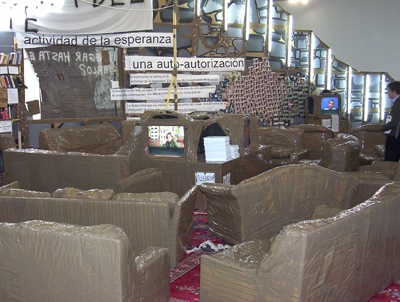Biennial of Contemporary Art of Seville
The second Seville Biennale marked Okwui Enwezor’s return to the “mega-exhibition” format for the first time since 2002’s Documenta_11. It also marked a shift in his critical focus: from the series of postcolonial displacements that underpinned Documenta_11, to a single-city exhibition grounded in a single theme. Enwezor reprised Sigmund Freud’s theory of ‘das unheimlich’ (literally translated here as ‘the unhomely’) and filtered it through contemporary geopolitics after the terrorist attacks on September 11, 2001, with particular reference to the ‘unhomely’ internment camp at Guantánamo Bay in Cuba and the ‘bare life’ of its generally rightless and unsighted inhabitants.
If the theme sounds somewhat broad – particularly when coupled with the exhibition’s sub-title of ‘Phantom Scenes in Global Society’ – then this breadth was more than compensated by the astonishing literalness with which some of the artworks approached contemporary politics. Images of war abounded. Ghaith Abdul-Ahad’s photographs showed American and Iraqi militants in battle, dully reminding us of the truism that all parties to a war commit violence. Josephine Meckseeper presented a suite of banal photographs documenting demonstrations against neoliberal globalisation – as though documentary photography of itself suffices as some kind of political stance. And the Spanish group El Perro exhibited a sculpture of a (presumably American) youth skateboarding atop three hooded, naked figures crouched in a pyramidal form. Just in case we didn’t ‘get’ the Abu Ghraib reference, El Perro kindly presented a photograph of an American soldier skateboarding in Iraq as well.
As representation after representation of journalistic images or twee references to oil passed me by, I couldn’t help but wonder whether art’s relationship to ‘politics’ could actually be something more than literal re-presentations of known scenes. What ever happened to institutional critique, for example, as an engagement with art’s own discursive politics as well as the Realpolitik surrounding art? This was a particularly pertinent question given both the biennale’s general lack of engagement with the locations housing it (the decayed Royal shipyards and a former monastery in the equally decaying 1992 World Expo playground) and its strong focus on relatively ‘conservative’ media such as painting and drawing. These media, we must remember, were largely perceived by critics to be lacking in the video-heavy Documenta_11. Had Enwezor capitulated to the desires of the art press? And could art’s politics be more than an opportunistic exploitation of images of people and lands that are themselves being opportunistically exploited today?
Some of the Biennale’s more intriguing works certainly confronted these questions head-on, especially Gerhard Richter’s gunmetal-grey Abstraktes Bild (2000) and its mute challenge to the very possibility of imaging war. Such works were, however, exceptions to the curator’s rule. For this was an exhibition overwhelmingly crushed beneath the burdens of the world – and of art’s own yearning for political relevance within it.
Anthony Gardner

image, Thomas Hirshhorn installation 2006
back to SPEECH
If the theme sounds somewhat broad – particularly when coupled with the exhibition’s sub-title of ‘Phantom Scenes in Global Society’ – then this breadth was more than compensated by the astonishing literalness with which some of the artworks approached contemporary politics. Images of war abounded. Ghaith Abdul-Ahad’s photographs showed American and Iraqi militants in battle, dully reminding us of the truism that all parties to a war commit violence. Josephine Meckseeper presented a suite of banal photographs documenting demonstrations against neoliberal globalisation – as though documentary photography of itself suffices as some kind of political stance. And the Spanish group El Perro exhibited a sculpture of a (presumably American) youth skateboarding atop three hooded, naked figures crouched in a pyramidal form. Just in case we didn’t ‘get’ the Abu Ghraib reference, El Perro kindly presented a photograph of an American soldier skateboarding in Iraq as well.
As representation after representation of journalistic images or twee references to oil passed me by, I couldn’t help but wonder whether art’s relationship to ‘politics’ could actually be something more than literal re-presentations of known scenes. What ever happened to institutional critique, for example, as an engagement with art’s own discursive politics as well as the Realpolitik surrounding art? This was a particularly pertinent question given both the biennale’s general lack of engagement with the locations housing it (the decayed Royal shipyards and a former monastery in the equally decaying 1992 World Expo playground) and its strong focus on relatively ‘conservative’ media such as painting and drawing. These media, we must remember, were largely perceived by critics to be lacking in the video-heavy Documenta_11. Had Enwezor capitulated to the desires of the art press? And could art’s politics be more than an opportunistic exploitation of images of people and lands that are themselves being opportunistically exploited today?
Some of the Biennale’s more intriguing works certainly confronted these questions head-on, especially Gerhard Richter’s gunmetal-grey Abstraktes Bild (2000) and its mute challenge to the very possibility of imaging war. Such works were, however, exceptions to the curator’s rule. For this was an exhibition overwhelmingly crushed beneath the burdens of the world – and of art’s own yearning for political relevance within it.
Anthony Gardner

image, Thomas Hirshhorn installation 2006
back to SPEECH

0 Comments:
Post a Comment
<< Home